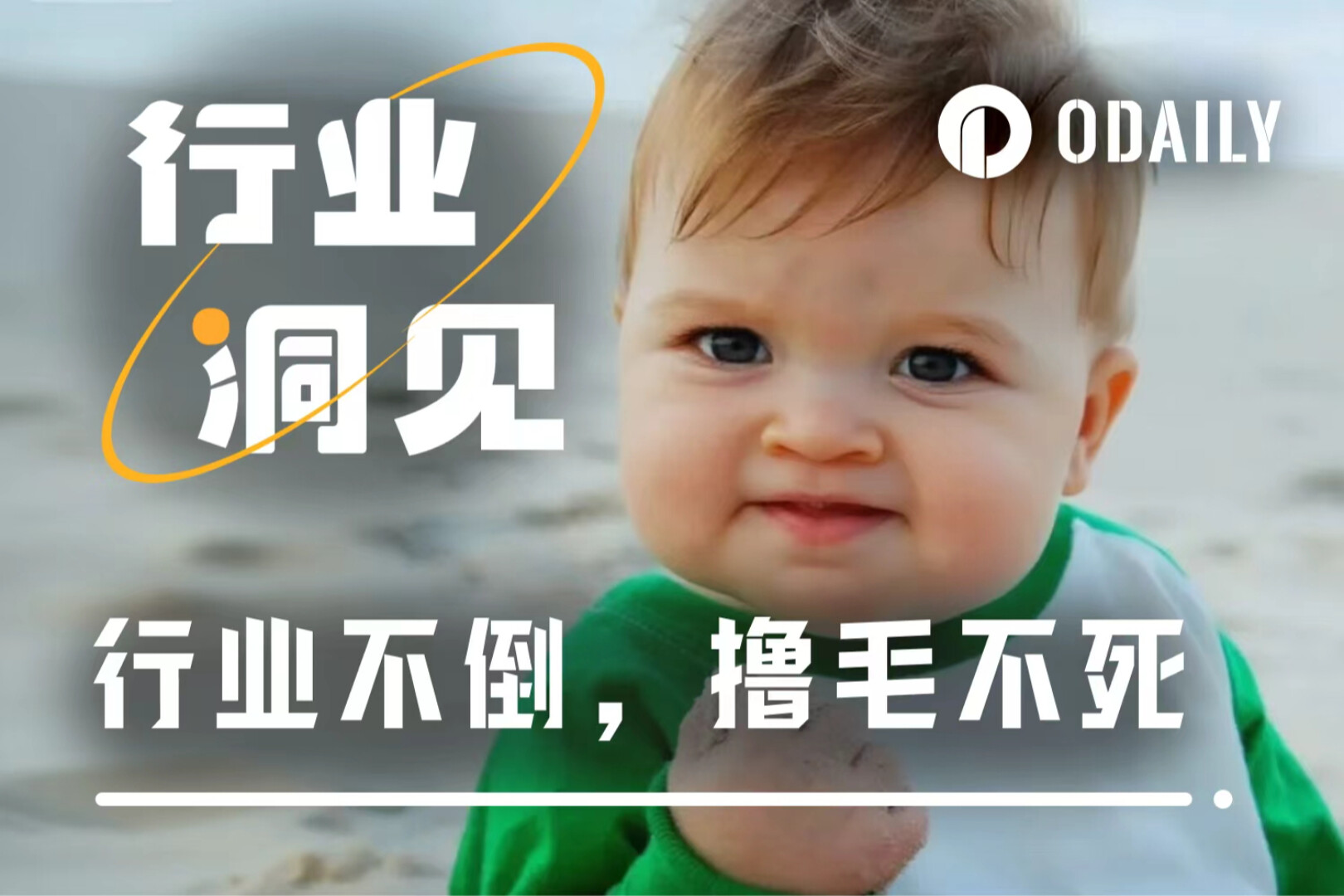一文带你了解近期比特币资产发行新协议
1. Rune.Alpha
The reason why Rune Alpha has become popular is mainly due to the concept of runes that has been highly discussed recently. The concept and origin of runes have been introduced in previous tweets, and I will briefly introduce them here.
The concept of Runes was originally proposed by Casey, and gained attention again due to BTC Core core developer Lukes opposition to Inscriptions. The essential difference between runes and inscriptions is that runes are stored in UTXO, while inscriptions such as BRC-20 based on Ordinals are JSON text stored in the Segregated Witness data of Bitcoin Script.
The Rune Alpha we are going to introduce here claims to be Rune, but according to the Rune Alpha white paper, it is a new inscription protocol based on the ordinals protocol version 0.11.1, and is not the same as the Rune proposed by Casey. Are not the same. So Rune Alpha is not actually a rune, it just gets the popularity of rune in its name.
However, it doesn’t matter whether it is a real “rune” or not. Rune Alpha has successfully gained popularity. You can have a bad reputation in the currency circle, but you must not lose your reputation. The minting cost of the protocols first token, $cook, is about a dozen U. The current over-the-counter price has risen to 400 U, and it has not yet been launched on the trading market.
2. CBRC-20
CBRC-20 is a proposal for an efficient meta-protocol standard for fungible tokens on Bitcoin through Ordinals. By leveraging the new metadata and metaprotocol fields introduced in ord 0.10+ (which allow arbitrary attributes to be stored directly within the Inscription envelope), CBRC-20 maintains the functional logic of the same BRC-20 metaprotocol while reducing the cost per inscription and simplifying indexing process.
Since CBRC-20 is an upgraded version of BRC-20, what optimizations has it achieved?
Reduced recorded costs
Deploying, minting or transferring any CBRC-20 token is accomplished simply by engraving the number “0” on the token. As a text file, inscriptions cost 10x less compared to other meta-protocol ordinal token standards.
Simplified indexing
CBRC-20 provides an easy way to index CBRC-20 meta-protocol status, as all information is available directly in each inscribed envelope.
MIME data flexibility
The CBRC-20 standard allows the use of any MIME data to deploy, mint, or transfer CBRC-20 tokens. Example: To issue an instruction to a token, you only need to fill in 0 as text content, which reduces the cost by 10 times compared to other Ordinals meta-protocols.
Compatible with later versions of Ordinals protocol
Unlike the BRC-20, which is limited to Ordinals version 0.9 functionality, the CBRC-20 can take advantage of the latest features introduced in Ordinals version 0.10 and above.
At present, the CBRC-20 team has not developed its own market, but has used various ingenious methods to put its own tokens on the trading market.
One is to directly launch Inscription SWAP through RuneX;
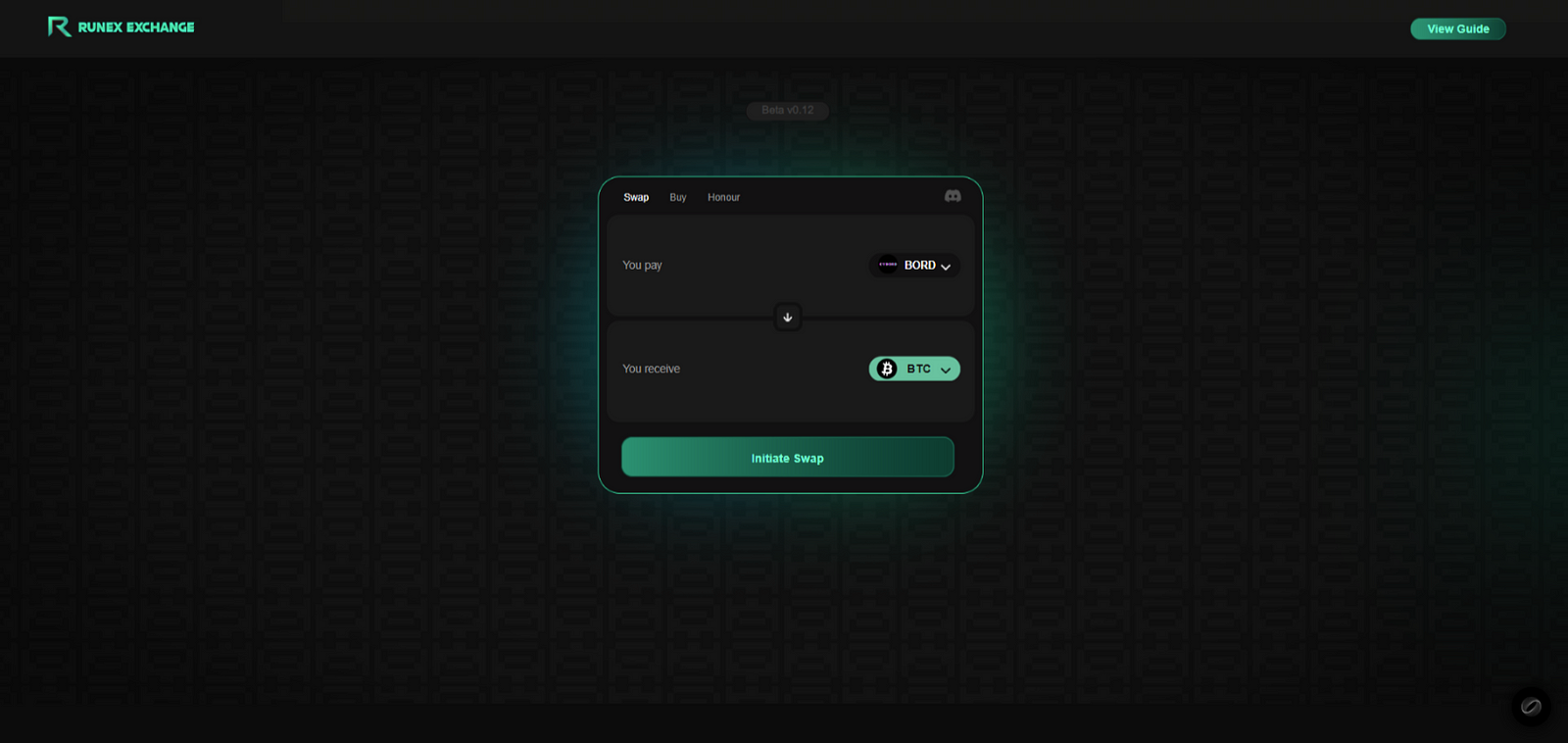
The other is to modify Unisat through Oil Monkey and directly force Unisat to be put on the shelves. The transferred inscriptions engraved are all cbrm collections. The founder made a Grease Monkey plug-in that can directly read the inscription information on Unisat, and then you can see which inscription it is.
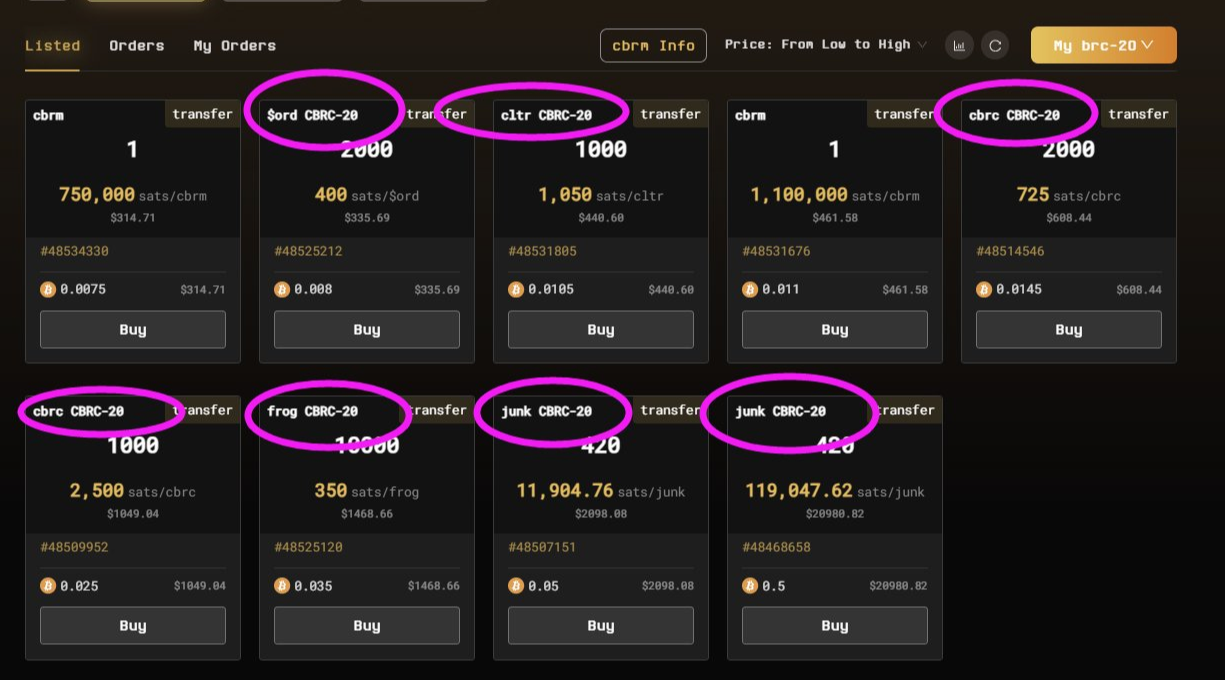
In addition to launching the above two trading markets, the community spontaneously created a trading market for CBRC-20 tokens, and attached CBRC-20 tokens to BRC-20 tokens, using a Trojan horse method to convert CBRC-20 tokens into CBRC-20 tokens. 20 tokens are listed on Unisat, but this method is highly experimental and does not guarantee the security of assets.
Recently the founder started an OSMOSIS experiment and deployed the first meta-meta protocol inscription $SYMM. How to understand meta-agreement and cross-reference?
Meta-protocol is the term used by the Ordinals community to describe interoperable protocols. Formalized through off-chain indexing of on-chain information (such as BRC-20, SNS, Bitmap, etc.).
Due to the non-overlapping nature of the two BRC/CBRC meta-protocols, operations such as deployment/casting/transmission of the two meta-protocols can be completed at one time. If the holder holds both, the $SYMM in his hand is valid. The picture below shows a two-in-one $SYMM inscription. The picture on the left is the inscription.
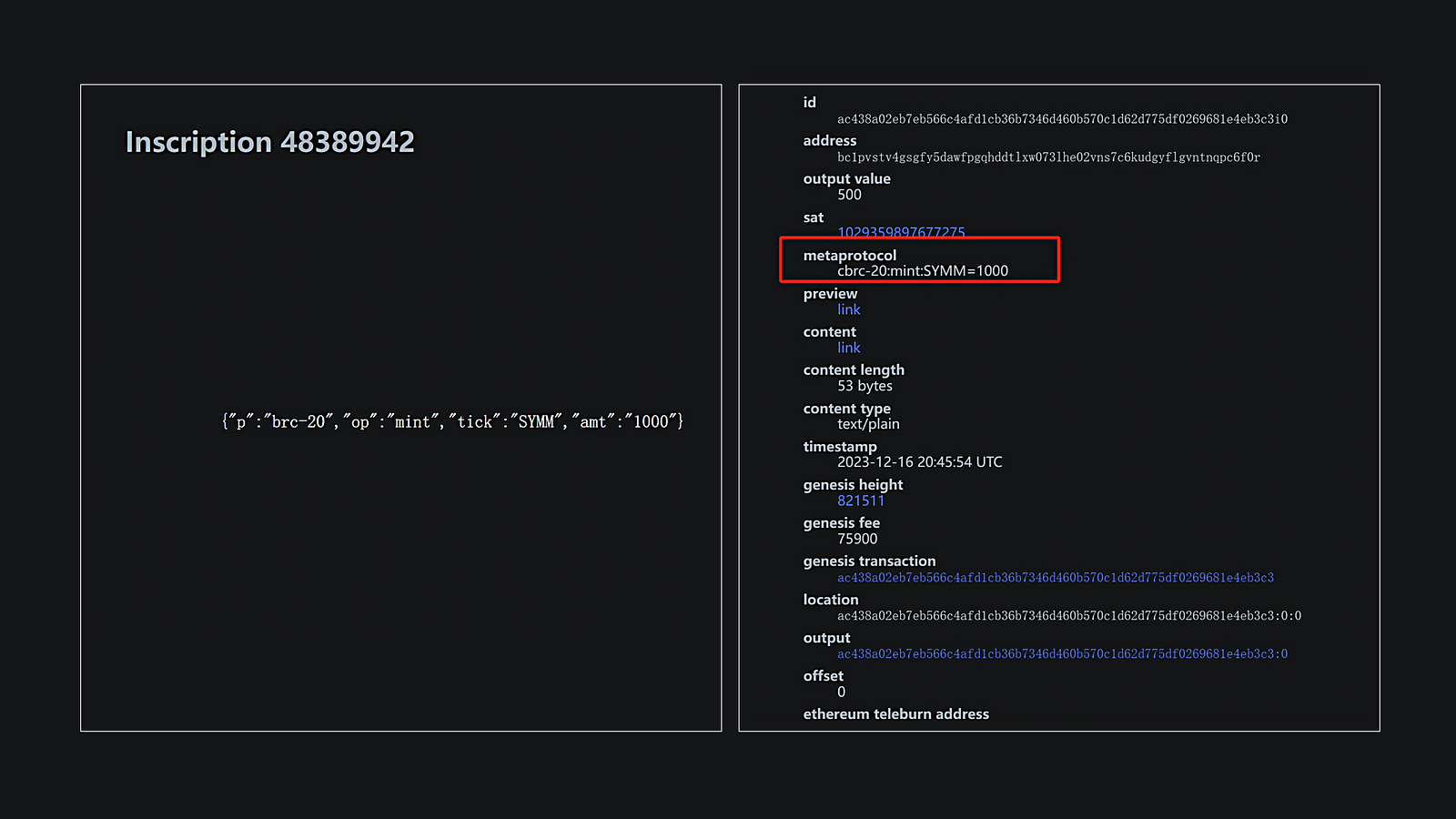
From an overview, CBRC-20 is like a Trojan horse. It uses the inscription method of CBRC-20 to engrave the inscriptions of multiple protocols at the same time, thus conducting a certain degree of vampire attack on other protocols. Just like the Trojan horse that the founder often tweets about, CBRC-20 has achieved a backdoor listing.
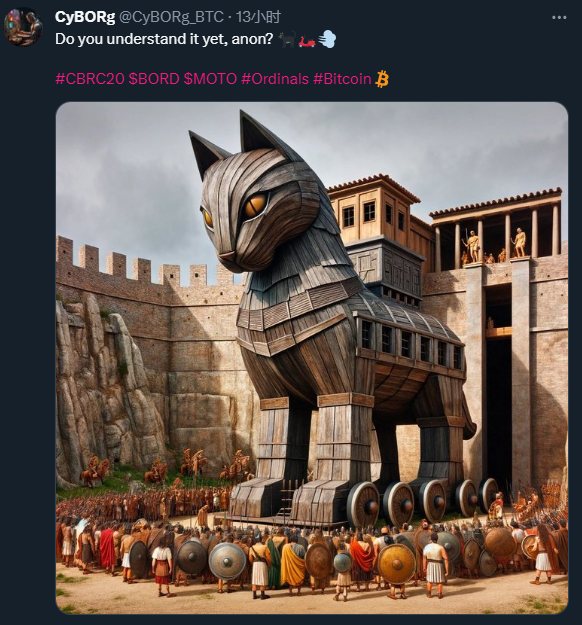
3. BTNS
Broadcast Token Naming System (BTNS, Broadcast Token Naming System) is one of the early BTC holders and development members @jdogresorg, and has built an ecosystem on the BTC main chain. The basic idea is to attach a broadcast signal to each BTC chain transmission, use the records on the blockchain as the data basis, and use the ledger index as a means to make it possible for BTC to release its own on-chain native asset tokens and NFTs.
BTNS-420 is a token protocol standard built by @jdogresorg based on BTNS that integrates multiple ecological features such as asset issuance and transfer. The emergence of BTNS-420 makes the idea of BTNS possible.
What is the difference between BTNS tokens and inscriptions and runes?
First of all, the token assets of the BTNS ecosystem have not been changed or occupied by BTC, which is more in line with the trend of the BTC ecosystem. The inscriptions and runes all rely on the BTC currency itself for storage, which will result in a large amount of BTC token occupation and resource waste. Asset casting based on broadcasting is more open and fair. Although the index is constructed by @jdogresorg, all broadcast data is stored in blocks following BTC transaction information. It is completely transparent and open to query. The existence of the index is more It is to limit and track the total amount of assets, rather than centrally indexing whoever you want to index.
BTNS does not have any potential risks, because BTNS has been completely open source, and all infrastructure construction is based on the extended development of the characteristics and functions of BTC itself, and there are no major controversial discussions.
What value does BTNS bring?
BTNS makes it possible to release assets based on the BTC main chain from impossible, and completely relies on the characteristics of BTC itself. Its release allows BTC to build all assets without loss of total consumption. With more improvements, it is very likely that BTC will become a fully playable, environmentally friendly mainstream ecological chain (note that it is an ecological chain, not a value currency)
The recent Inscription Rune revolution has brought about the BTC congestion problem. The author believes that if BTNS is introduced to build an ecosystem, its own framework and upgraded token protocol will allow for airdrops, fair indexing (referring to regulations or specific instruction indexes), etc., so that assets will no longer rely on grabbing, not first-come-first-served, and gas will be used first. It is a fairer way to obtain it, such as registering address airdrops, stipulating block limits, and even low-gas transaction indexing.
According to the community, @jdogresorg is on vacation and has suspended development work, and judging from its Twitter updates, this is indeed the case. Therefore, the market that was supposed to be developed has not made progress yet.
Summarize
The above is the introduction of the recent new Bitcoin protocol. Both Rune Alpha and CBRC-20 do not break away from the concept of inscriptions. They are both an asset issuance method based on Ordinals. However, CBRC-20 does a better job in innovation, allowing It becomes possible to cast inscriptions of multiple protocols at the same time. BTNS is conceptually larger than the two. BTNS belongs to the category of meta-protocol, while Rune Alpha and CBRC-20 both belong to layer two protocols (referring to standards or protocols developed based on original protocols such as Ordinals), and BTNS In the form of broadcasting, asset issuance on Bitcoin no longer occupies Bitcoin (the merits of occupancy or not will not be evaluated here).
Related websites
Rune Alpha official website:https://runealpha.xyz/
CBRC-20 official website:https://cybord.org/explore.html
Reference article
Disclaimer: All contents on this website may involve project risk matters and are for science and reference purposes only and do not constitute any investment advice. Please treat it rationally, establish a correct investment philosophy, and increase your awareness of risk prevention. It is recommended to comprehensively consider various relevant factors, including but not limited to personal purchasing purpose and risk tolerance, before interacting and holding. Copyright notice: The copyright of the quoted information belongs to the original media and author. Without the consent of Jian Shu J Club, other media, websites or individuals are not allowed to reprint the articles on this site. Jian Shu J Club reserves the right to pursue legal liability for the above-mentioned acts.


